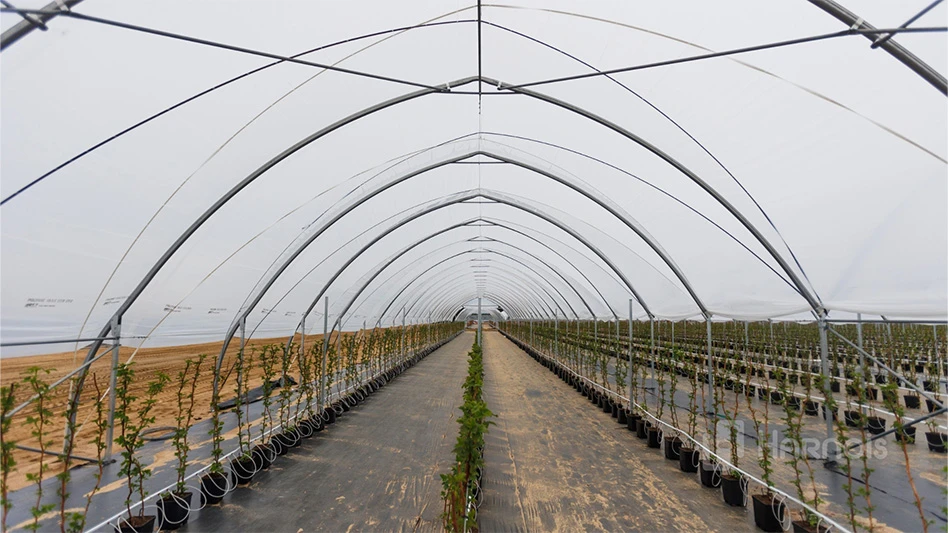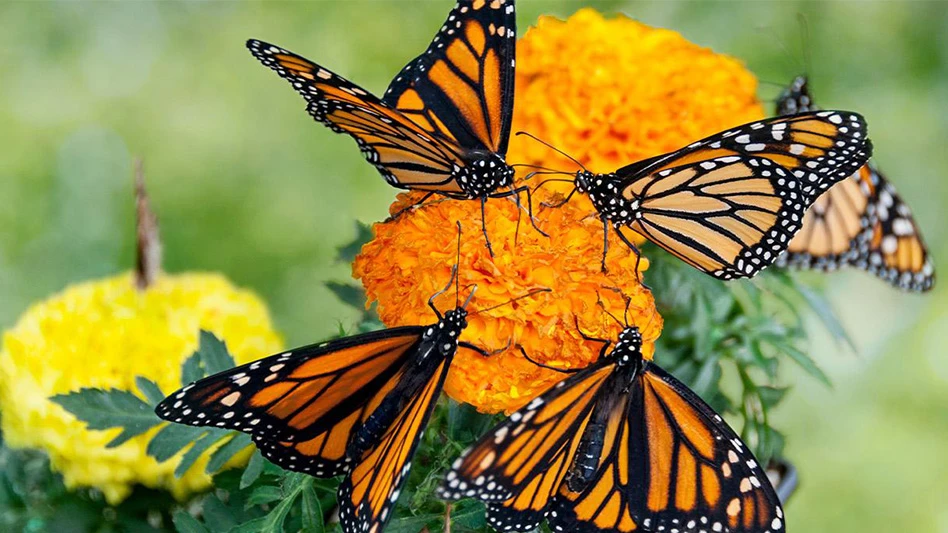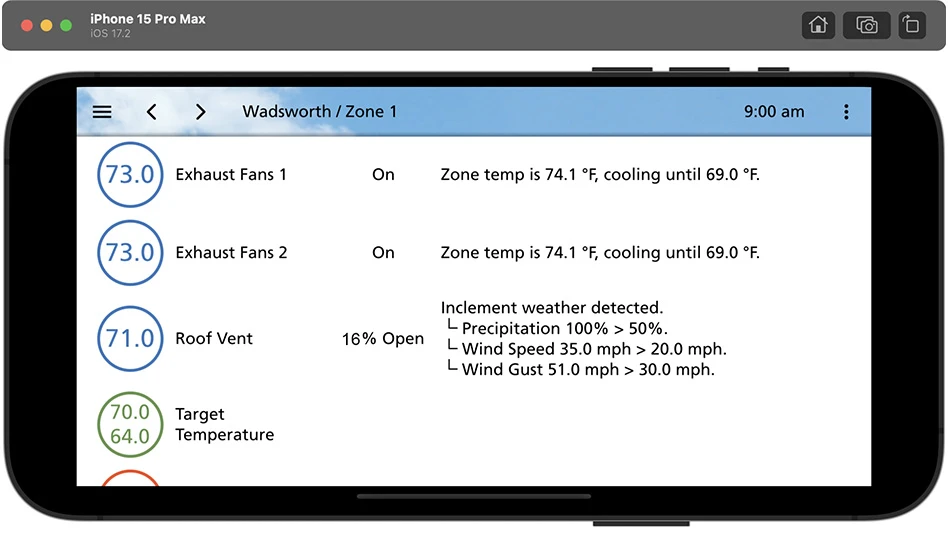.jpg) Dan GilreinBiological controls have been a hot topic among people in the New York greenhouse industry. Thanks to a grant from the New York Farm Viability Institute and with support from New York State Flower Industries, the staff of the New York State IPM Program, Cornell University entomologist John Sanderson and local extension personnel have been conducting hands-on biological control workshops. At one Long Island workshop nearly half of the attendees had used or were currently releasing natural enemies into their greenhouses to control insects and mites. Sanderson pointed out that recent issues with insecticide resistance, particularly with western flower thrips and Q-biotype whitefly, have done a lot to raise interest in biocontrols.
Dan GilreinBiological controls have been a hot topic among people in the New York greenhouse industry. Thanks to a grant from the New York Farm Viability Institute and with support from New York State Flower Industries, the staff of the New York State IPM Program, Cornell University entomologist John Sanderson and local extension personnel have been conducting hands-on biological control workshops. At one Long Island workshop nearly half of the attendees had used or were currently releasing natural enemies into their greenhouses to control insects and mites. Sanderson pointed out that recent issues with insecticide resistance, particularly with western flower thrips and Q-biotype whitefly, have done a lot to raise interest in biocontrols.
Cost of insecticides and miticides is another factor. Several growers have said they were reluctant to purchase a quart or pound of a control product when only a few ounces may be required. Use of biocontrols is generally highly compatible with normal greenhouse work activity, and releases can be done by almost anyone with a minimal amount of training.
A learning experience
Actual use of biological controls is still unfamiliar territory to many growers. The workshops have been designed to introduce growers to a few of the more useful natural enemies — learning their names, showing them what they look like, providing application information and where to go for support.
Biological control guidelines
There are several important guidelines covered in the workshops.
- Natural enemies are almost always best used preventively, before an infestation is noticed. When a mite or thrips outbreak is first seen, it is too late to start releasing biocontrols. Unlike most insecticides or miticides, biological controls aren’t used to clean up an existing problem.
- Match the appropriate biocontrol to the expected pest. There are various predators, parasitoids and pathogens, and each has a specific use. Sometimes two or more are used in combination or alternation.
- Some pesticides are compatible with biological controls. This may be important in case a new pest problem arises or a biological isn’t working as expected. However, many pesticides are not compatible with biologicals. Their application may result in having to wait a long period (i.e. months) after use before beneficial insects and mites can be safely released again.
- A simple quality assurance plan is needed to verify that biologicals arrive alive and in the quantity ordered, and to make sure they are working as intended after they are released.
What’s being released
Some of the beneficial insects and mites and their uses discussed in the Cornell workshops include: Encarsia (Encarsia formosa), a tiny parasitoid wasp used mainly for greenhouse whitefly. Eretmocerus eremicus, another wasp, is used for silverleaf/sweetpotato whitefly.
Aphidius colemani is a parasitoid wasp used to control small aphids such as melon and green peach aphid. It is not used for larger aphid species such as foxglove aphid.
Neoseiulus cucumeris is a predatory mite that attacks the early-stages (mainly first instar nymph) of thrips.
Hypoaspis miles, a predator mite, is released on the soil of the greenhouse or the growing media to control fungus gnat eggs and larvae, and for thrips pupae.
Atheta coriaria, a predatory rove beetle, controls the eggs and larvae of fungus gnats and shore flies and thrips pupae in the soil or growing media.
Orius insidiosus (minute pirate bug) is a predator of thrips and occasionally other small insects.
Steinernema feltiae is a beneficial nematode that is used for fungus gnat larvae and for thrips pupae in the soil or growing media.
Some of the biologicals can be used in combination for the same or for different pests as needed. If plants aren’t blooming when the biological releases are started, a source of pollen is a helpful alternative food source for Orius and N. cucumeris. One or two releases may be adequate for some biologicals, such as Atheta, or additional releases may be needed every seven to 14 days (N. cucumeris). Work with biological suppliers or a specialist on release rates and timing for your particular situation.
Quality control is critical
When we receive a natural enemy shipment at Cornell, a portion is reserved to verify the biological survival.
For Encarsia, Eretmocerus and Aphidius, a card or dispenser is placed in a one-pint screw-top Mason jar, in which a small piece (1- by 2-inch) of yellow sticky card is hanging from a twist tie. A piece of fine mesh (such as nylon stocking or organdy) is placed over the top and the band is screwed on. The jar is marked with the shipment arrival date and put in a location out of direct sunlight and maintained at room temperature. After several days to a week, the emerging wasps become stuck to the sticky card, indicating they have survived and providing an estimate of the number received.
For predatory mites, shake out some of the shipping medium onto a white or black surface. Look for the faster-moving mites. They are often shipped with bran mites as a food source. Bran mites are slow-moving, usually in higher numbers and have long hairs on their bodies, which are visible with a hand lens or OptiVisor.
For Orius and Atheta, the insects should be easy to see and active when the package is opened. Nematodes, after mixing with water, should be moving after a short period of time. A hand lens is usually needed to see them.
Suppliers should provide handling instructions. A local extension specialist or consultant can be helpful in becoming more familiar with handling and distributing the natural enemies on or around the plants.
Monitoring biologicals
After releases are made, scout for evidence the biocontrols are doing their job. For Encarsia and Eretmocerus, the black (Encarsia) or tan (Eretmocerus) parasitized whitefly pupae should be visible. For Eretmocerus, we more often find dead whitefly nymphs. Aphids parasitized by Aphidius wasps become easy-to-see tan, inflated mummies.
Predators are harder to track directly. Occasionally I have observed predatory mites, especially those that control spider mites, near their prey, but often are hard to find after releases.
Scout weekly for pest levels. If they fail to increase as expected, this is a possible indicator that the biologicals are doing their job. If pests are found, flag them with tape or a stake. Use these plants as a release point and then monitor closely how the infestation continues to develop.
Alternative control choices
If things don’t go as planned, or an unanticipated disease or pest problem requires a pesticide application, the Koppert Side Effects List is a reference for the most compatible options. You’ll need to know the name of the biological control and the pesticide active ingredient. Sometimes timing the application around releases of natural enemies can minimize any negative impact.
Banker plants
In addition to providing a source of pollen, banker plants act as alternative sources of prey for hungry natural enemies.
For aphid natural enemies, this involves rearing a grain aphid (e.g. bird cherry-oat aphid) on barley or oat plants that are spread around a crop. Grain aphids don’t become pests of greenhouse plants, but help to maintain the natural enemies within the crop. Beneficials may reproduce on these alternate host aphids as well. Entomologists Lance Osborne at the University of Florida and Graeme Murphy at the Ontario Ministry of Agriculture, Food and Rural Affairs, have written about the use of banker plants.
Making a commitment
There is no need to be concerned about releasing beneficial insects or mites into a crop. We have had no reports of problems at time of sale, even after one grower accidentally left some biological release cards hanging on a shipment of poinsettias. Another grower received favorable comments from a retailer about use of biocontrols. We may be missing some “green” marketing opportunities.
Growers using biocontrols have said it takes a commitment to make it work. Managing these controls is certainly more complicated initially than using insecticides. There is a learning curve to anything new and some compelling reasons to make natural enemies a part of the normal way of growing plants.
Dan Gilrein is extension entomologist, Cornell University Cooperative Extension, Long Island Horticultural Research and Extension Center, (631) 727-3595; dog1@cornell.edu.

Explore the January 2010 Issue
Check out more from this issue and find your next story to read.
Latest from Greenhouse Management
- Star Roses and Plants introduces Martha Stewart Rose
- Hoffman Nursery announces David Hoffman as CEO, Craig Reynolds as COO
- Plantpeddler releases Poinsettia Variety Day 2024 results
- Sarisa insecticide now registered for drench applications and many common greenhouse vegetable crops
- Ball FloraPlant launches redesigned website
- Costa Farms wins Top 10 Marketing Team at 2024 OnCon Icon Awards
- Thank you(!)
- Construction begins at Dramm’s Fish Fertilizer Facility in Wisconsin





